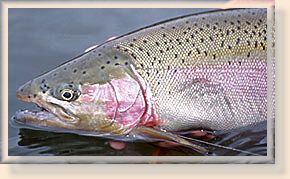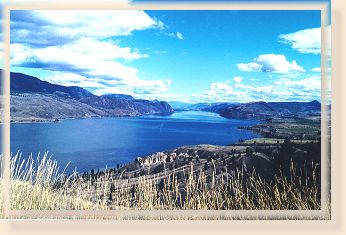The High Desert Lakes of British Columbia
Part One
By Gordon Honey
The quality stillwaters region of British Columbia defined geographically
as, south of Prince George in the north, east of the Coastal mountain range
to the west, and east to the foothills of the Rocky Mountains. The southern
area extends to the U.S./Canadian border. This is the central interior, a
diverse land of alpine meadows, rolling ranch land and semiarid desert valleys.
The number and diversity of the lakes within this region is astounding, for
example in the Kamloops region alone, there is two hundred lakes within a
60 mile radius of the city. The central interior of British Columbia is truly the
stillwater capital of the world, a fly fisher's paradise!
The Quarry
 The premier sport fish of the region is the Kamloops trout Salmo kamloops,
named in 1892 by Dr. D.S. Jordan of Stanford University. The Kamloops
trout is a sub species of the rainbow trout Salmo gairdneri now referred to
by biologists as Salmo gairdneri kamloops. It is a common belief that the
Kamloops trout evolved from the Thompson River Steelhead, resulting in
their bright silver coloring and their world renown fighting qualities! Kamloops
trout are now available to anglers the world over, thanks to stocking exchange
programs, can be found as far away as New Zealand, and are currently stocked
in lakes in Oregon and California.
The premier sport fish of the region is the Kamloops trout Salmo kamloops,
named in 1892 by Dr. D.S. Jordan of Stanford University. The Kamloops
trout is a sub species of the rainbow trout Salmo gairdneri now referred to
by biologists as Salmo gairdneri kamloops. It is a common belief that the
Kamloops trout evolved from the Thompson River Steelhead, resulting in
their bright silver coloring and their world renown fighting qualities! Kamloops
trout are now available to anglers the world over, thanks to stocking exchange
programs, can be found as far away as New Zealand, and are currently stocked
in lakes in Oregon and California.
Kamloops trout range in size from one half pound to as much as twenty pounds
(Interior anglers generally size fish by pounds rather than inches). These sizes
vary from lake to lake based on the following factors: lake depth, water
chemistry and average temperature, shoal structure, aquatic vegetation,
and impacting on all of these factors, elevations. Larger fish are more
common in lakes at elevations of 1000 ft, to a maximum of 5000 ft.
Mountain lakes beyond the 5000 ft. level do not support significant numbers
of large fish, due to water chemistry and a limited growth period created
by winter ice, and the shorter spring and summer seasons. These lakes
are populated by an abundance of smaller fish, and provide a wonderful
dry fly experience. Large fish lakes are typically shallow, averaging
approximately fifteen feet to a maximum of twenty to twenty-five feet,
full of nutrients and aquatic vegetation, these lakes are almost one vast
shoal! The single major factor responsible for this productive fishery is
the rainshadow effect created by the Coastal and Cascade Mountain
Ranges, resulting in annual rain fall less than 9 inches and therefore a
high desert. Respected American writer Ted Leesen captured the essence
of our lakes and fish in his June 1997 article in Field & Stream.

"Rainshadow Rainbows" he wrote "By any measure, the lakes of southern
British Columbia must be reckoned the crown jewels of the rainshadow
waters. The city of Kamloops is the angling epicenter, and the Kamloops
trout is the heart of the game. A girthy, muscular fish, with the luster of
machined titanium that hints of its genetic roots in the Thompson River
strain of steelhead." He continued "I can think of worse ways to spend
a lifetime than fishing the lodgepole-rimmed waters where all the trout
have wings."
Our Ministry Of Environment, Fisheries Branch has been very successful
with the genetic engineering of Triploid females. These sterile females
grow slower, bigger and live longer, there are now 30 lakes with Triploid
rainbows and some Eastern brook trout. Additional species that are of
interest to the stillwater fly fisher in B.C.'s Central Interior, would be
Kokanee O.nerka kennerlyi, a fresh water sockeye salmon that has
residualized and remains in fresh water. Kokanee have become a
respected sport fish and are generally found in our larger bodies of water.
A large kokanee would be three pounds while the average would be one
pound (patterns, tactic, and key time periods parallel those of the Kamloops
trout).
Considered by the majority to be inferior in sport quality, the third and final
stillwater species available to the fly anglers, is the Eastern Brook trout
Salvelinus fontinalis, introduced years ago in an attempt
to reduce the pressure on our better Kamloops trout lakes during the
winter ice fishing. The brookie does not receive much angling pressure
during ice off, and can therefore provide an interesting and challenging
alternative, especially during the heat of summer. Tactics, patterns and
habitat can be very different from that of the Kamloops trout, providing
a pleasant diversion; average sizes are comparative to the Kokanee.
More next time. ~ Gordon Honey
Credits: From Angling in the Shadows of the Rockies
by Jeff Mironuck We thank
Frank Amato Publications, Inc. for use permission!
Our Man In Canada Archives
|

